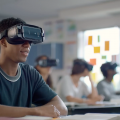How to Use Augmented Reality and Virtual Reality in Education Industry?

It is also making education more convenient. This combination allows each child to focus on the exact areas where they have room for improvement rather than falling behind, as well as to allow other children to forge ahead rather than waiting for other kids to catch up. Access to AI will also help prepare students for future work environments that are also increasingly incorporating AI into job responsibilities. The application development opportunities are nearly endless.
What is Augmented Reality?
The easiest way to describe augmented reality is that this AI technology superimposes different sounds, images and text into the real-life scenes we see on electronic device displays. Some examples of AR are Pokemon Go, Iron Man and Instagram filters that give you dog ears and place butterflies above your head. Basically, AR is when you see things that are not actually there as you look at a screen displaying real life in real time. Some current and practical uses include airports using AR to display directions to a flight connection, furniture stores allow you to see what a piece of furniture might look like in your house and surgeons use it to create a plan of action prior to cutting into a patient.
What is Virtual Reality?
Unlike AR, virtual reality uses environments and scenes that are completely computer generated based on realistic scenarios rather than superimposing images in real life. Users are able to explore the 3D-generated space in a number of capacities. Because you are completely immersed in the false environment, your senses and perceptions are easily persuaded to believe you are really there. Currently, you can explore a museum in another country as if you were standing in the museum yourself. It is used in various forms of entertainment from video games to films. And, architects and doctors use VR to determine whether or not a design or technique will work in a virtual setting before making applications in real life.
Augmented Reality and Education
AR mobile app development continues to grow each day. One of the greatest advantages of AR in the educational development of children is the ability it provides teachers to personalize the learning experience. AR programs can assess the level at which a child understands a subject matter. This allows the teacher, or the program, to create homework plans that cater to the child’s specific shortcomings rather than to reiterate areas in which the child already understands perfectly well. It also provides a more engaging methodology for doing homework thus increasing the likelihood the child will actually complete the assigned homework. AR also makes field trips more interactive and educational.
Virtual Reality and Education
VR is yet another way to make learning more fun and engaging. Children are able to take field trips to anywhere in the world rather than being limited to only local activities. Many kids are visual learners, and as such, teachers can use VR environments to teach subject matter more effectively. If kids have the ability to experience and see exactly what it was like during the Roman Empire, they are far more likely to absorb the information and to be interested in the topics. It can also be used to develop skills and to learn foreign languages far more quickly. And, it is proving to be highly useful and successful in special education classrooms.
AI is only going to continue to expand into every facet of one’s life as application development continues to expand. In April 2018, comScore Connected Home revealed that 20 percent of US homes now use a smart speaker, also referred to as a digital personal home assistant such as Amazon’s Echo and Google Home. This percentage continues to grow significantly on a monthly basis. This type of artificial intelligence technology is only the beginning, and both administrators and children can benefit greatly from utilizing AR and VR applications in schools worldwide from mobile app development to personalized tutors.
Hire Mean Stack Developers | Mobile App Developers | .Net Development
Other articles and publications:
Articles and publications of other companies:
- +1 (732) 588-7500
- 315 W 36th Street
- www.otssolutions.com/











